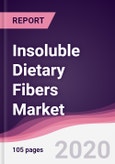The global insoluble dietary fibers market is estimated to be $1,965m in 2020 and projected to grow at a CAGR of 7.8% during 2020-2025 in terms of value however volume sales is poised to witness higher growth during the forecasting period. The Asia Pacific region is estimated to be the fastest developing market for insoluble dietary fibers. This is because of the rising demand for functional food as well as the change in the lifestyles of the population. Followed by Europe and North America because of the rising demand for dietary and health supplements. The global insoluble dietary fibers market is estimated to reach 762.4KT in terms of value by 2021 growing at a CAGR of 8.8 % during the forecast period from 462KT in 2020.
Insoluble Dietary Fibers Market Outlook:
Hemi-cellulose & cellulose holds major share in the global insoluble dietary fibers market in 2020 with volume shares of 24.5% and 30.3% respectively. Chitin & Chitosan type of insoluble dietary fibers are estimated to witness rapid growth both in terms of volume & value during the forecast period. Food & Beverages is the major market for insoluble dietary fibers globally and it is estimated to continue its growth both in terms of volume & value during the forecast period.
Insoluble Dietary Fibers Market Growth drivers:
The consumer’s inclination towards fiber rich products, increasing demand for functional foods and abundant availability of raw materials is driving the growth of the insoluble dietary market. Booming functional food industry outgrowth the usage of dietary fibers. Additionally the growing population of insoluble dietary fiber as a nutritional ingredient.
Insoluble Dietary Fibers Market Challenges:
Escalating competition within dietary fiber segments and among various nutritive ingredients stands as a challenge for the growth of insoluble dietary fibers. In addition reduction of anti-nutrient components in cereals brans for their use in nutritional products stands as a challenge
Insoluble Dietary Fibers Market Research Scope:
The base year of the study is 2020, with forecast done up to 2025. The study presents a thorough analysis of the competitive landscape, taking into account the market shares of the leading companies. It also provides information on unit shipments. These provide the key market participants with the necessary business intelligence and help them understand the future of the Insoluble Dietary Fibers Market. The assessment includes the forecast, an overview of the competitive structure, the market shares of the competitors, as well as the market trends, market demands, market drivers, market challenges, and product analysis. The market drivers and restraints have been assessed to fathom their impact over the forecast period. This report further identifies the key opportunities for growth while also detailing the key challenges and possible threats. The key areas of focus include the types of plastics in the electric vehicle market, and their specific applications in different types of vehicles.
Insoluble Dietary Fibers Market Report: Industry Coverage
- By Type: Hemicellulose, Lignin, Cellulose, Resistant starch, Chitin & Chitosan, Fiber, Others
- By Function: Anti-Caking Agent, Bulking/ Texturing Agent, Fat Substitute, Water binding Agent, Others
- By Sources: Whole grain, Vegetable, Fruits, Others
- By End-Use Industry: Food Industry, Animal feed Industry, Pharmaceutical, Others
Insoluble Dietary Fibers Market report also analyzes the major geographic regions for the market as well as the major countries for the market in these regions.
The regions and countries covered in the study include:
- North America: The U.S., Canada, Mexico
- South America: Brazil, Venezuela, Argentina, Ecuador, Peru, Colombia, Costa Rica
- Europe: The U.K., Germany, Italy, France, The Netherlands, Belgium, Spain, Denmark
- APAC: China, Japan, Australia, South Korea, India, Taiwan, Malaysia, Hong Kong
- Middle East and Africa: Israel, South Africa, Saudi Arabia
Insoluble Dietary Fibers Market Key Players Perspective:
ADM Alliance Nutrition, Inc., a wholly owned subsidiary of Archer Daniels Midland Company (NYSE: ADM), has announced it will sponsor the American Competitive Trail Horse Association (ACTHA), the first organization of its kind to champion trail horses by showcasing their value and distinction across breed and discipline boundaries. ADM Alliance Nutrition equine nutritionist and equine product and technical manager Dr. Judy Reynolds said in an interview
“ADM Alliance Nutrition is excited to sponsor the American Competitive Trail Horse Association, an organization that shares our enthusiasm for helping horses be their best.” said Dr. Judy Reynolds, “ACTHA champions all horses, regardless of breed or discipline. Likewise, ADM Alliance Nutrition offers programs designed to meet the unique nutritional needs of horses of varied breeds.”
Some of the Key players in this market include: Cargill Inc., J.Reltenmaier & Sohne Gmbh & CoKg., Roquette Freres, Archer Daniels Midland, Ingredient Inc., E.I.DuPont De Nemours and Company and others.
Market Research and Market Trends of Insoluble Dietary Fibers Market
- Insoluble dietary fibers increases the weight of stool and decreases the transit time of colonic that guarantees the prevention of constipation and diverticulosis. One of the major benefit of insoluble dietary fibers is their antioxidant capacity which comes phenolic and thus contributes in their health aids. Inspite the proven health benefits of insoluble dietary fiber on risk reduction of chronic disease, the average consumption of it is seen low globally. There is persistent need for daily intake of insoluble dietary fiber.
- The number of patents has observed an abrupt growth in 2013 & 2014 because of the swelling demand and active investment from stake holders. The growing need for new formulations and related applications, patents and intellectual properties are playing a key role in maintaining the competitive position in the market
Table of Contents
Methodology

LOADING...








